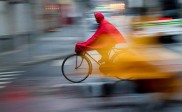Take Better Pictures with Your Mobile Phone
Photography isn’t limited to point and shoot cameras and DSLRs. A lot of phone manufacturers are putting high resolution cameras into their phones making them viable photographic tools. Apple, Samsung, HTC, etc. are pushing the phone photography into a new level.
Almost all mobile phones have a camera. Unfortunately this has no effect on the output of mobile phone photographs. A lot of them are still of poor quality. This article will help you maximize your chance to take better pictures with your mobile phone camera.
Good Lighting

Photo by the walking disaster
Photography is about light. If high end cameras require good lighting to capture great photographs, the same is also true for mobile phones. When taking a picture, always take note of the light. If shooting in daylight, find a shade area. If shooting at night, turn on some light or use your phone’s flash. You can also use the flash as fill when shooting outside.
High Resolution

Photo by flatworldsedge
DSLRs can opt to use RAW or various JPEG settings. The same can be said for phone cameras with their resolution settings. A lot of users use the smallest resolution possible to save space. However, this means that you don’t capture all the details possible. And when you try to print or post your pictures online, the quality will be sub par. Storage space is very cheap right now so buy a high capacity memory card and take high resolution pictures.
Post Processing

Photo by Matt Burrows
Straight from the camera pictures would be better if edited. You can use applications to edit them in your phone but ultimately you will achieve better pictures when you edit them in your computer. You have more flexibility and the possibilities are endless.
Proper Posture
The dimensions and weight of a mobile phone differ greatly from a DSLR. This means that you hold them differently. With a DSLR, weight is an advantage since it can help you stabilize more. It also forces you to use both of your hands achieving less blurry photos. With a mobile phone, you are used to holding it with a single hand. And, pressing the shutter while using a single hand will inevitably create blurry pictures. To fix this, use both of you hands when taking a photo. Much like what you would do when using a point and shoot camera. Try not to lean too much when taking a photo. And remember that your camera will have some shutter lag. Unlike DSLRs, your mobile phone will take a second or more to take the picture so keep your hands during that time.
White Balance
A lot of ruined photos from mobile phones are a result of wrong white balance settings. The camera phone’s system of detecting the proper white balance isn’t that good so you’re better off setting it manually.
You still can play with the white balance to achieve some cool color effects.
Composition

Photo by Matt Burrows
The most common composition rule is the rule of thirds. This is the easiest to follow and can create stunning photos. However, don’t shoot all your photos with this rule in mind. There are a lot of composition rules out there that you can use. And when you are familiar with them, you can start experimenting and using your own style of composition.
Using a mobile phone as a tool for photography is not much different from using a DSLR. The basic elements of photography are still there. The only thing that changed is the tool you use. You’re also limited in some aspects but those can be easily fixed. With this in mind, try to use your mobile phone camera, keep on shooting and embrace the light!




Good tips here!
Checkout my mobile photography at http://blog.joshuachoo.com
Great article – I’m amazed at how well cellphone shots come out. They also offer some advantages, particularly in terms of candid shots and portability. Thanks for including one of my shots in the illustrations!
Most camera phones are simpler than separate digital cameras. Their usual fixed focus lenses and smaller sensors limit their performance in poor lighting. Lacking a physical shutter, most have a long shutter lag. Flash, where present, is usually weak.